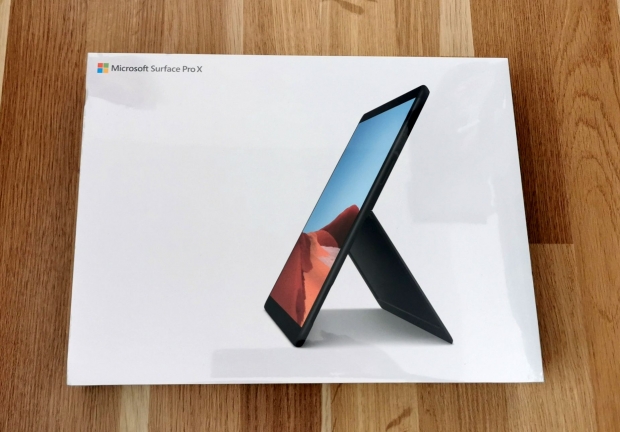Nailing the Surface X Pro deal is a big step for Qualcomm’s Always Connected PC (ACPC) initiative. Surface Pro X shows Microsoft’s commitment to both software and hardware, and it finally makes more sense why the software giant invested heavily to make its Windows 10 operating system ARM-compatible.
Microsoft has released an Intel-based Surface Pro 7 and even and AMD-based Surface laptop, as the company wants to be CPU- and platform-agnostic.
What About Surface Pro X Hardware?
The new Surface Pro X is thinnest and lightest surface 2-in-1 powered by Qualcomm’s 8CX processor. Don’t be confused by the SQ1 name. What we call Qualcomm 8CX, Microsoft’s marketing department refers to as the Microsoft SQ1 processor. The SQ1 is marketed as a custom SoC designed by Qualcomm, backed by a two teraflop Adreno GPU. To put this into perspective, the first discrete GPU to boast teraflop performance was AMD’s Radeon HD4850, a high-end product launched 11 years ago. Today, you can get twice the performance from a GPU integrated into a mobile SoC, which sounds impressive.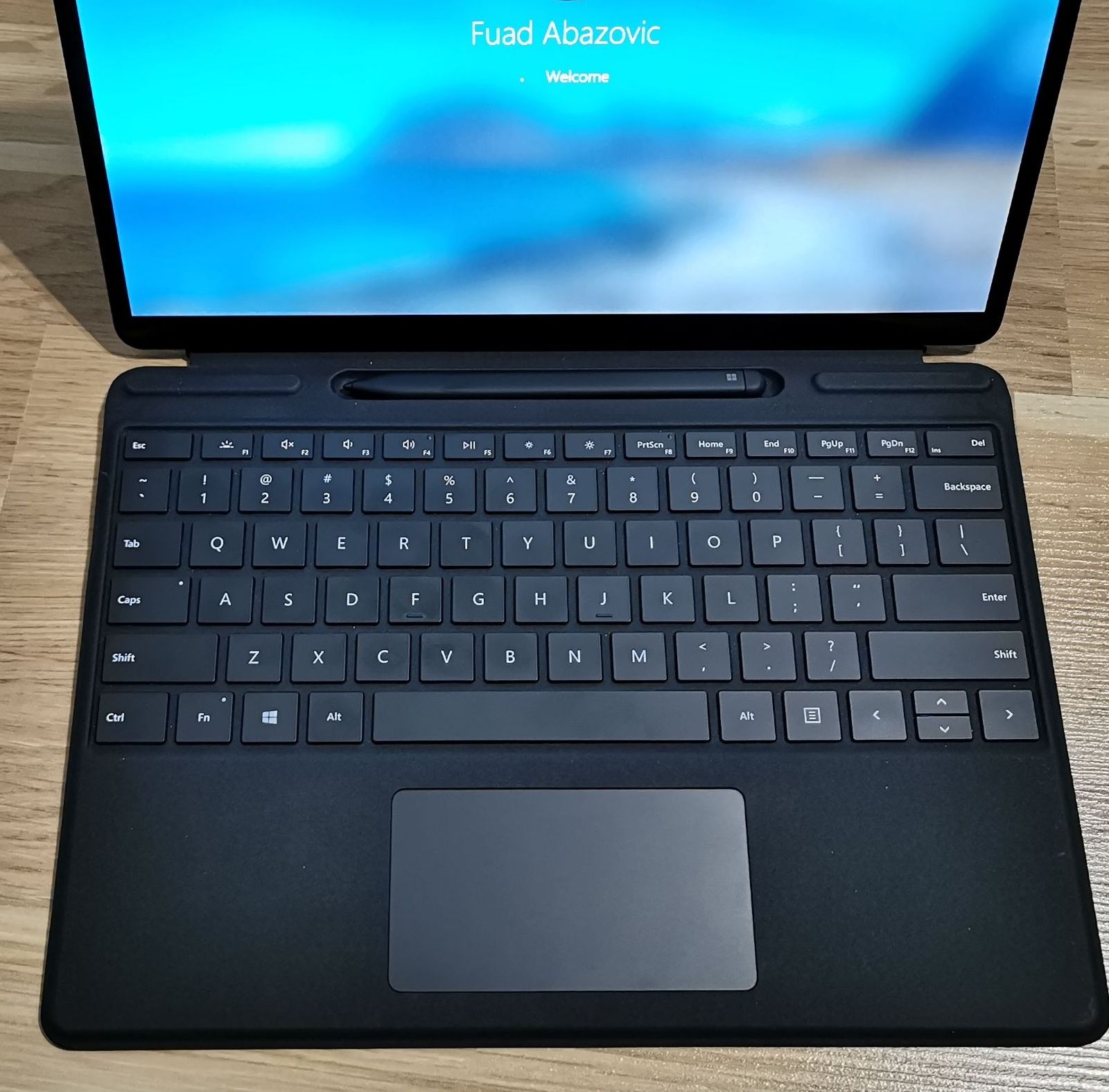
Compared to Qualcomm 8CX, Microsoft’s SQ1 SoC features higher clocks on both the CPU and GPU. It is powered by the Kryo 495 CPU, with four cores clocked at 3GHz (the 8CX variant runs at 2.84 GHz). The low power cluster of four CPU cores runs at 1.8Ghz in both cases.
Microsoft is using the Adreno 685 GPU, a 2TFLOP part, while the original 8CX comes with Adreno 680 and 1842.5 GFLOPs of potential performance. So, in essence the Microsoft SQ1 is an overclocked or binned SoC, notably improved for the needs of Microsoft’s Surface line. The Hexagon 690 DSP runs 9 TOPS and a Spectra ISP capable of 192 Megapixel camera support. Microsoft is using the Windows Halo camera, consisting of a front five-megapixel unit and ten-megapixel rear camera.
One of the key value propositions of Surface Pro X is the X24 integrated 4G LTE modem and always connected standby.
Surface Pro X Design and Build Quality
The Surface Pro X measures 287x208x7.3mm (11.3x8.2x0.28-in) and tips the scale at 774g (1.7 lbs), without the Type Cover. Microsoft is very secretive about the weight of the Type cover. We used a Signature Keyboard with Slip Pen and used a digital scale to get the answer. It weighs 293 grams (0.646 lb) with the stylus. In other words, the whole package weighs just over one kilogram, or 2.2lbs.
Microsoft went with black anodized aluminum, which looks incredibly stick, but at the same time it is a magnet for fingerprints. In other words, it won't look as great after carrying it, and a cloth polishing should become part of your everyday routine.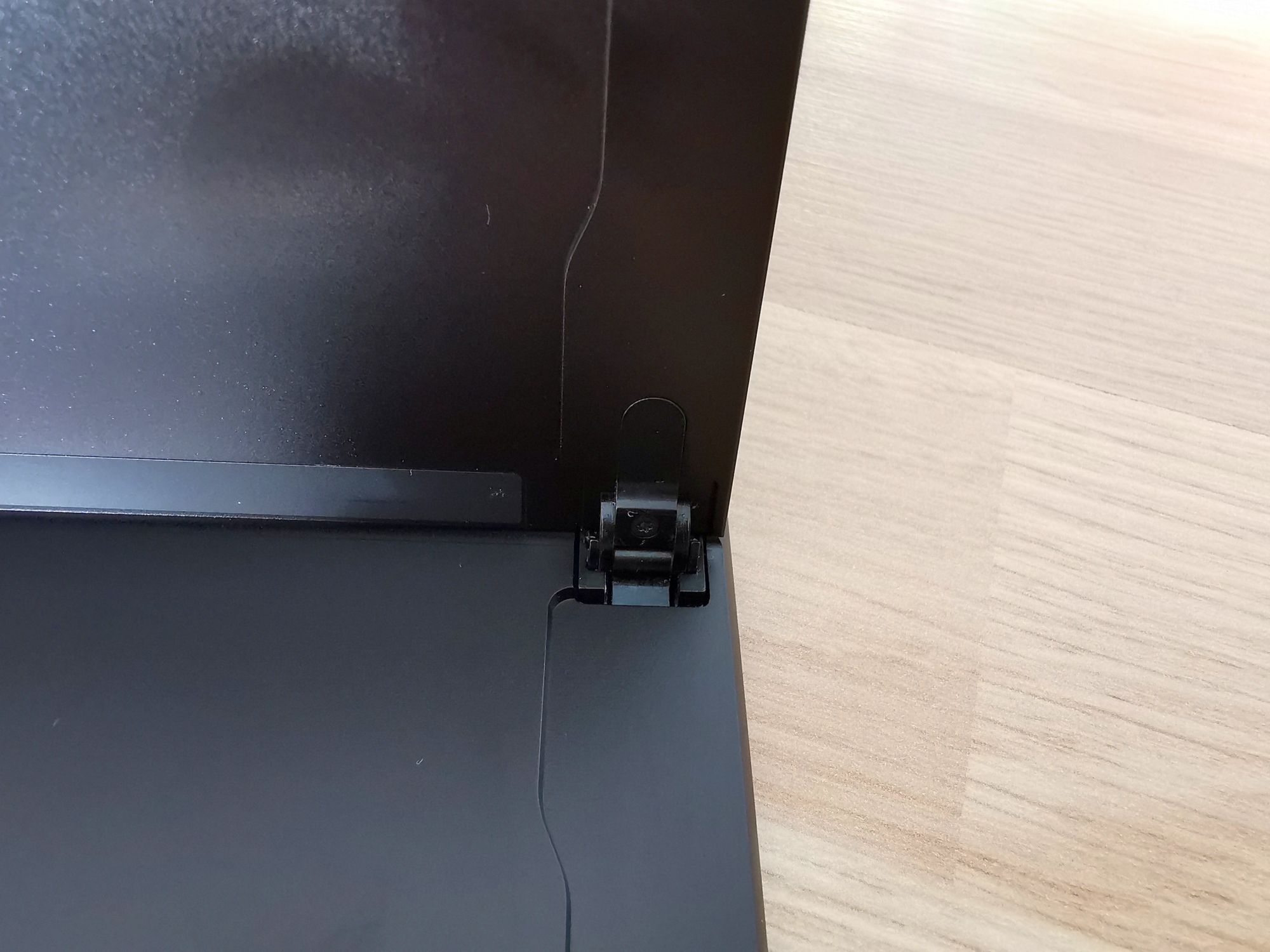
The Pro X sports a 13-inch PixelSense Display with 2880x1920 resolution (267PPI), 3:2 aspect ratio, and 450 nits of brightness. Microsoft is advertising that the screen has 33 percent thinner bezels, which allowed them to integrate a 13-inch edge-to-edge screen in the footprint of a typical 12-inch device.
The Surface Pro X comes with a minimum of 8GB of RAM, and there is an option to get 16GB of LPDDR4x-3733 RAM. The upgradable storage comes with 128GB, 256GB, or 512GB of NVME SSD storage. The SSD in 128GB version we tested comes from Toshiba, now KIOXIA KBG40ZNS128G.
https://www.tomshardware.com/reviews/toshiba-bg4-m.2-nvme-ssd-review,6330.html
Users Cannot Swap Out the SSD?
The SSD drive is not available for consumers and is being sold as OEM-only part. It’s in the tiny M.2 2230 package, and it is easy to access. The downside is that Microsoft is clear that they should do any SSD change. So, unless you know people at Knoxia, previously known as Toshiba and OCZ before, you might need to rely on Microsoft for all storage upgrades. While other vendors also ship M.2 2230 drives, we did not have any at our disposal to try swapping them ourselves. We might try to get a Western Digital 2230 SSD and install it in the Surface Pro X, and we will let you know once we try it out.
Fanless Design
One key change compared to all previous Surface machines is that the X Pro doesn’t have active cooling - it is a fanless, silent design. In addition to being silent, it’s thin and light at the same time. The PCB is small as Qualcomm's background is building SoCs for phones and other mobile devices, which are very dense and space-constrained, yet the new Surface is a 13-incher.
Microsoft only tells that you should expect a 13-hour battery life on average, but there is no mAh rating for the battery.
The 13-inch screen in the body, usually hosting 12.x screens promises skinny bezels. The bezels are thin on the sides, and the attached keyboard makes sure to hide the bottom one too. So, in reality you will only see the brow of the notebook hosting two cameras.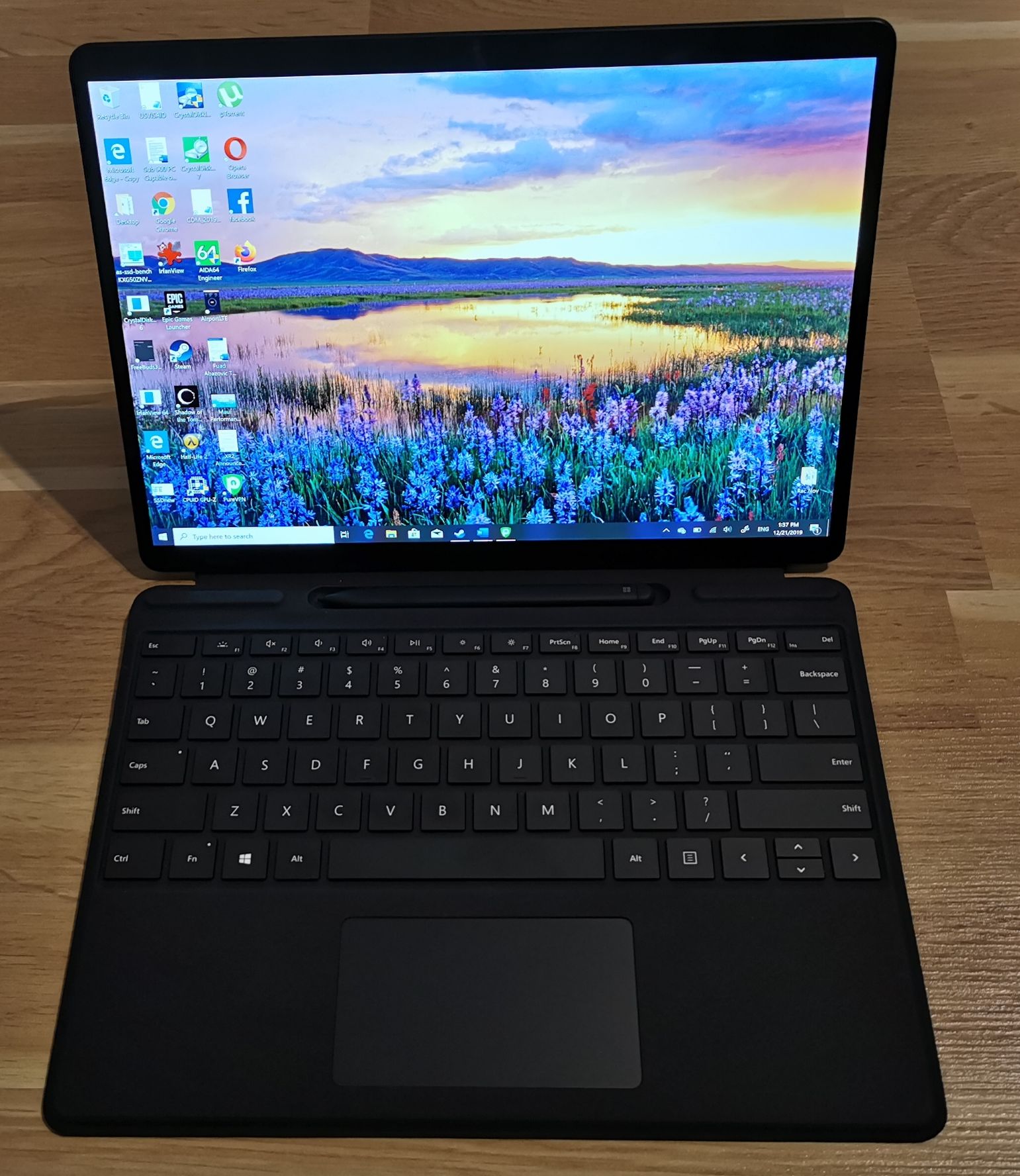
The touchscreen is big, bright, and beautiful. The 2800 x 1920 resolution and 3:2 format with 450 nits of brightness will be great for most users. I spent quite some time with last year's XPS 13-inch 4K screen, but I have to admit that it is hard to distinguish that the Surface Pro X has any fewer pixels. The pixel density is high on both, and cramming more pixels into 13-inch panels doesn’t make much of a difference.
Connectivity and Expansion Options
The Surface Pro X comes with two USB-C ports, a Surface Connect port, Surface Keyboard connector port, and nanoSIM bay. The nanoSIM and the changeable SSD are placed at the rear side of the device below the kickstand.
There is a small screw and a nanoSIM tray inside. I tried using a local SIM card and it just worked instantly. You insert the pin if it is enabled, and you are good to go.
Two USB-C 3.1 ports will help you connect docking stations and storage devices. I am happy to report that the Surface Pro X will charge with USB Type-C power as long as your charger can pump out enough power. The machine ships with a 65W power adapter with Surface Connect port. One neat thing is that the charger has an extra USB Type-A slot to charge your additional devices, sorry Pixel users with two-sided Type-C cables.
Aside from the ability to easily find a replacement charger should you ever need one, reliance on Type-C charging is a boon for anyone connecting their Surface Pro X to a desktop monitor. All you need is a $20 Type-C third party hub that will allow you to connect a desktop monitor, keyboard and mouse, and DC power, transforming your Surface into a desktop through a single Type-C cable and hub. Anyone who has ever dealt with laptop docking stations will surely appreciate the practicality provided by Type-C.
Top of the machine is button and connector free. The left side has the volume rocker on the top, two USB Type-C ports (no microSD), while the right-hand sports has the power button and Surface Connect port. The bottom hides the Surface Keyboard connector port.
Surface Pro X as a Tablet
Without the keyboard, the Surface Pro X is one big and powerful Windows 10 tablet, but with limited usability. I find it challenging to be productive on the touch screen keyboard, but in this mode, watching movies, and browsing the internet will do just fine. I just would not type this mode, not after typing 5250 characters with spaces on a touch screen.
People complain about the lack of a 3.5mm audio jack, but Bluetooth worked just fine. Qualcomm is known for quite good Bluetooth, and two sets of over the ear Audio Technica AC700BT or Huawei FreeBuds 3 in-ear headphones worked well. It is time to let the wire go and meet its maker. If you cannot live without an audio cable, there is a Surface USB-C to 3.5 mm audio adapter for $11.99. It cost the same € 11.99 in Europe, though you can easily find cheaper third-party alternatives. Alternatively, if you really don’t want to rely on Bluetooth or buy dongles for your old headphones, you can always pick up a pair of Type-C headphones on the cheap. Chances are you will want them for your phone, too.
Keyboard
Two keyboards are available, with the standard unit selling for $139.99 in the US or €144.99 in Europe. The Surface Pro X Signature Keyboard with Slim Pen Bundle selling for $269.99 in the US and € 294,99 in Europe. Even though the pen is quite slick, this is way too much money for the bundle, and also, even the standard keyboard is more expensive than it should be.
When it comes to overall pricing, Microsoft’s management borrowed the tactics from customers ripping Apple. It overcharges way too much for storage options and accessories, as the customers don’t have a choice. 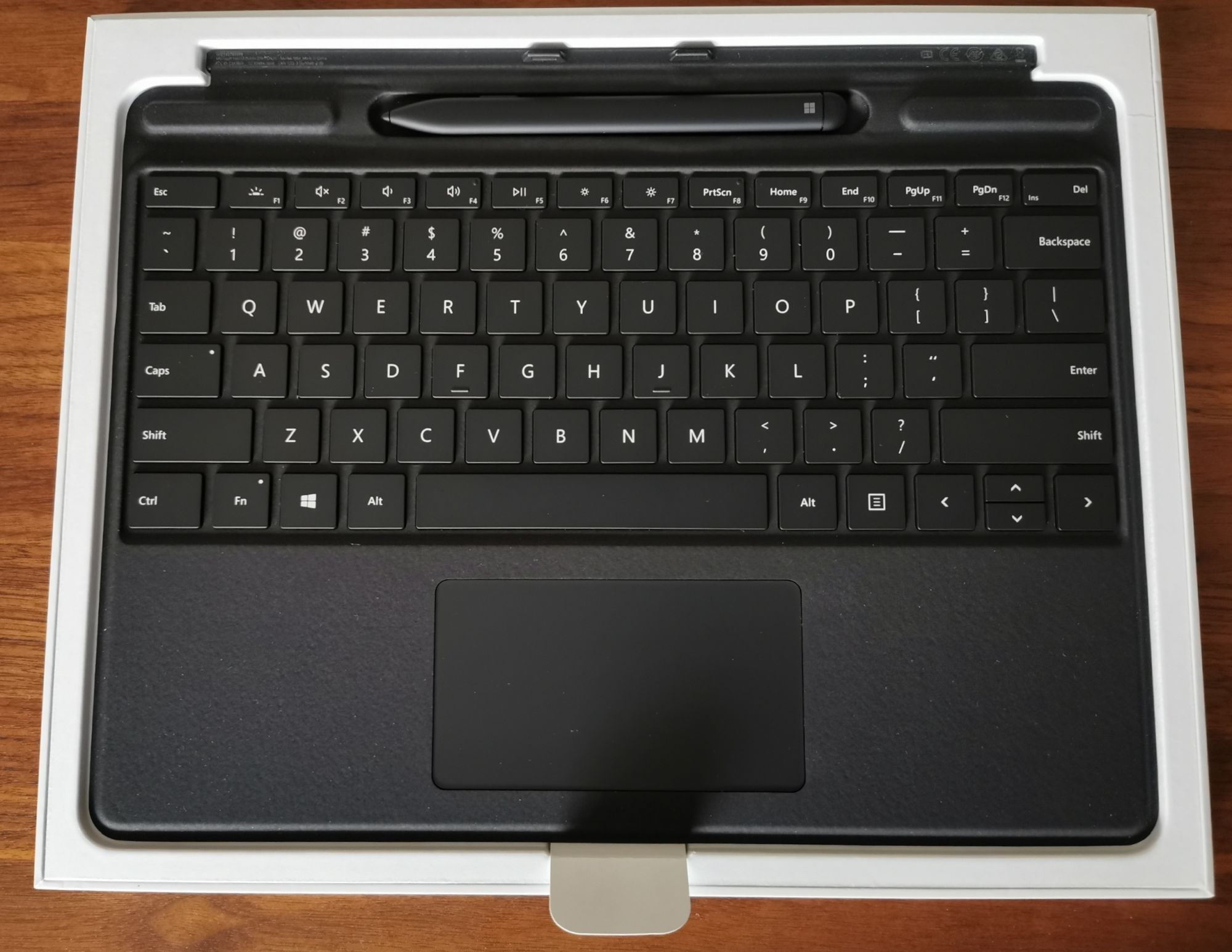
Back to the Signature Keyboard. It is made from an Alcantara material covering the keyboard and wide glass touchpad. It is comfortable to type on, no argument there. Like any keyboard, one needs to get used to it, but after a while it becomes very convenient. The keyboard weighs 280 grams, and the pen weighs 13 grams for a grand total of 293 grams, at least according to our digital kitchen scale. Microsoft doesn’t share these figures on its website.
With the Signature Keyboard and pen, the Surface Pro X weighs 1.037kg or 2.286 pounds. This makes it one of the lightest laptops, 2-in-1s, call it whatever you like. On top of that, the machine doesn’t have an annoying fan, has great battery life, and comes with excellent mobile data support out of the box. 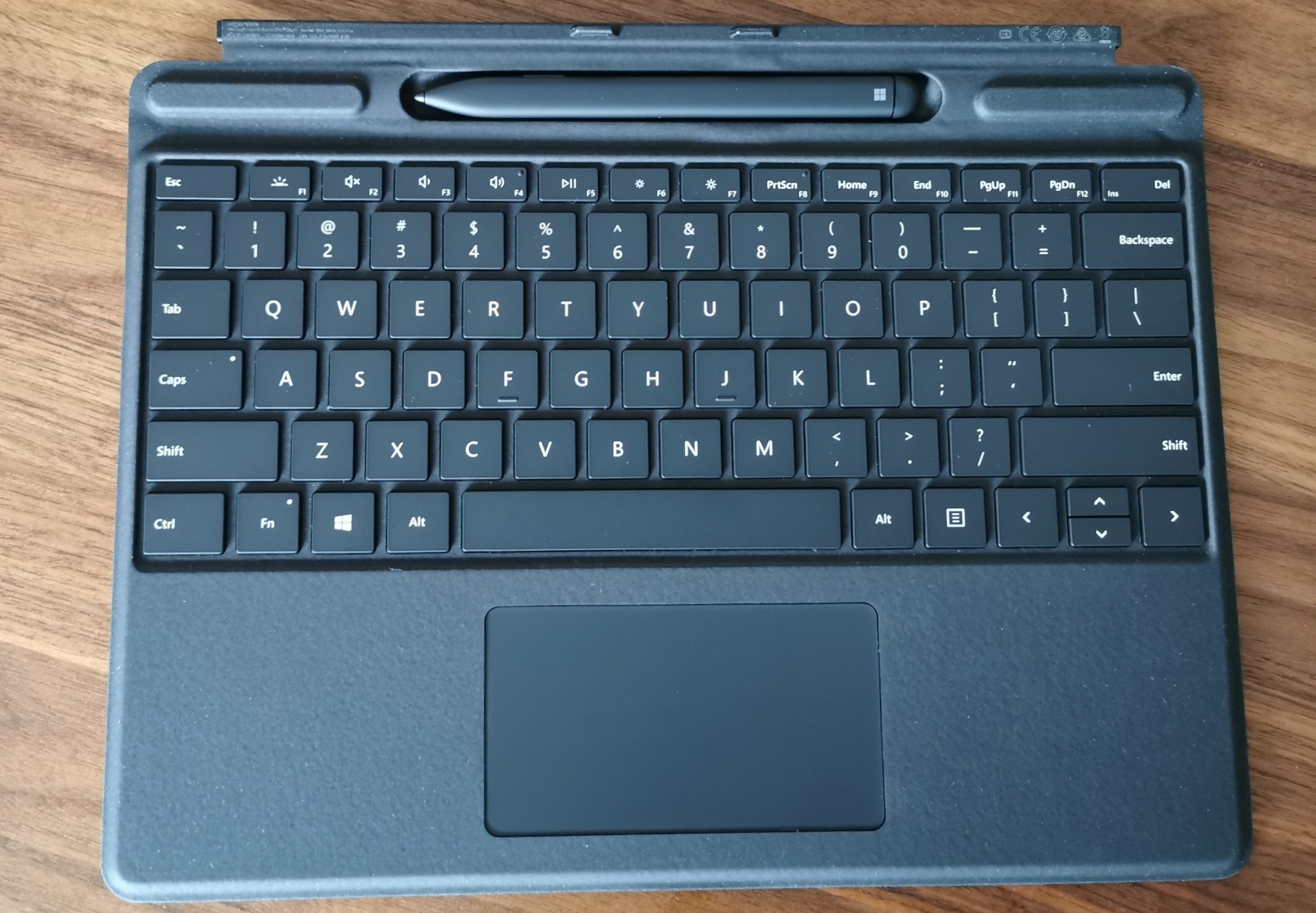
The keyboard is magnetic and snaps to the bottom side of Surface X Pro. As part this magnetic dance, it will hide the pen. The pen has its slot where it automatically charges. The option is a very smart decision as it will enable you to always have a pen with you, and it will always be appropriately charged, and you’re not likely to lose it. The fact that the keyboard can fold to hide the pen is also significant.
Everyday Use and Installation
You take the machine out of the neat package, take the wrap off and boot it up. It is a Windows 10 Home system that most of you know quite well. The installation is straightforward, it will ask you a few questions about the settings, Microsoft account, and it will boot up.
Since it is Windows, it will want to update; there is always something to update, and this time it was the Windows 1909 update. It was surprising to see that ARM-powered machine is getting the update at the same time as the x86 version. Microsoft makes no distinction, which is a good sign.
I installed Chrome and it worked just fine. There is currently no ARM native version, and for the sake of battery life, I would suggest using the Edge browser for now. Chrome, even with the emulation layer, worked just fine. There should be ARM native versions of Chrome coming for the platform, hopefully in the near future.
The IrfanView picture viewer and editor worked just fine too. It is not Photoshop, but it gets the job done. Another tool I frequently use is called Pixlr, and it worked flawlessly for editing and cropping pictures.
I went to the Microsoft store and installed Photoshop Express and Adobe’s Acrobat Reader. Both worked just fine.
For productivity sake, we installed Office 365 again, nothing extraordinary to report here. One of the biggest wins for Qualcomm and Microsoft’s Surface X Pro powered by Windows on ARM CPU is that you cannot tell that this is not an Intel-powered machine. It will work just fine for everyday users, people relying on common apps used by most users.
I was able to use Outlook, Word, Excel, and PowerPoint just if I was on my Intel-powered machine. Again, this is a huge success and a major step forward.
The new remote desktop works outstanding, and I was able to connect via 4G/LTE to one of my machines. It worked like a charm, as I was able to work on the other desktop, just as if I was sitting in front of it. I had to live with the fact that Surface X Pro has a 13-inch screen while the desktop I connected to had a 27-inch display. It was still scaling everything well, and with a good LTE connection, I was not even noticing that I was linked to a remote machine. Remote desktop can come in quite handy.
The 128GB model of Surface X Pro we tested would ran out of storage space quite fast, especially when we tried installing and playing a few games. Just for the fun of it, I installed Steam and Half-Life 2, and have to say that I was impressed that even at the native 2880x1920 resolution with all details at max the fanless machine with Adreno 680 was running at 190FPS+. We need more time and possibly an SSD upgrade to try some of the latest games, but it is clear that Surface X Pro is not targeting gamers.
I did install World of Tanks with its 43GB installation file, and this undemanding yet popular game ran just fine, delivering playable framerates. Curiously, one of our editors is a WoT fan, and he runs the game on multiple PCs, including an old ITX machine with a compact GTX 950 card. The good old GTX950 is a mid-range Maxwell 2.0 card launched in 2015, manufactured on TSMC’s 28nm node. The GTX950 consumes up to 90W of power and delivers up to 1.825 TFLOPS, which is still about 10% less than the integrated Adreno 685 GPU of the Surface Pro X.
This should put Adreno’s performance-per-watt into perspective. On paper, the integrated GPU can keep up with a 4-year-old 90W discrete card, which is impressive, to say the least.
Mobile Data and WiFi
LTE is on board the Qualcomm 8CX / Microsoft SQ1 SoC. It is deeply integrated into every fiber of the platform. Qualcomm comes from a communication background and knows why Gigabit LTE makes a difference. The Snapdragon X24 modem is capable of LTE Category 20 (2000 Mbps) speeds in Downlink using a 7x20 MHz carrier aggregation and maximum 20 spatial streams.
The modem supports up to 256-QAM with up to 4x4 MIMO on five carriers, Full-Dimension MIMO (FD-MIMO). The uplink supports LTE Category 13 (316 Mbps) with 3x20 MHz carrier aggregation and 256-QAM. The actual modem feature support will depend on your local carrier.
We’ve seen speeds up to 70 Mbps download and 45 Mbps upload, but this was throttled by the local carrier, and one can expect faster speeds. Despite speed test score we’ve seen 9 to 10 MB/s download on LTE from the Microsoft store.
The best part of having an integrated LTE is that you won’t depend on the airport WiFi. One can argue that tethering from the phone is also a viable option, but this drains the phone’s battery faster and it is not as elegant.
Customers who can share the data plans on two or more devices will benefit from having an always-connected PC on the go.
Battery Life
Microsoft claims 13 hours, and this would based on watching some video and doing some light browsing. You can get to this number especially on the video front, and if you crank down the brightness you can get even more. Thirteen hours is score worthy of our respect.
Out traditional travel work that includes emails, browsing on Wifi / LTE, watching some videos on the plane, and a lot of writing. We were getting between 7 and 8 hours, which was still good.
We will come back and update this part, as I don’t feel I spent enough time testing the battery. The 13 hours on 50 percent watching downloaded content from Netflix, Amazon Prime, or Disney+ is realistic. Battery life can be extended even more if the brightness goes a bit down, which is not unusual for watching any movies or TV shows on the plan. Obviously, using LTE all the time will impact your battery life.
Accessories
If you get a machine with 128GB or even 256GB of storage, you might run out of space. The user updates on the SSD are hard. Once we find the time and a suitable drive, we will give it a try and let you know if swapping out the SSD will work.
Until then we found a decent solution. The MINIX NEO Storage hub with 240GB cost $99.90 while 480GB version $129.90. Apart from getting you much needed additional storage, this USB Type-C multiport SSD storage will add an HDMI 4K up to 30Hz, 2X USB 3.0 (Type-A), and USB Type-C with power delivery. The MINIX NEO Storage hub is originally made with Apple Mac in mind, but we have confirmed that it works with Surface X Pro as well as XPS 13 2018 from Dell or Xiaomi 12 inch Intel Y-series based notebook.
Microsoft, of course, has its accessories, including Panzer glass for $49.99 in the US that is sold out and Privacy Panzer glass for $59.99, also sold out. Europeans don’t even get this option at Microsoft.com, but they get to buy a leather sleeve for €59.95, Kensington lock for €55.99, and a Surface dock for quite steep €229.90. This one will offer two Mini DisplayPorts, one Gigabit-Ethernet connector, four USB 3.0, one Audio out, Surface Connect cable as well as external power connector.
Benchmarks were a tough topic, as most of them simply won't run on the Surface Pro X. Compatibility with Qualcomm’s ARM-based platform is something that companies like UL, GeekBench, and a few others will have to fix, and with promised X64 bit support for the ARM-based ACAP there will be easier to compare the Intel versus Qualcomm machines in the future. Unquantifiable user experience is always hard to measure, but the Surface X Pro feels snappier than the Lenovo 630 based on the Snapdragon 850 processor.
Having a massive GPU and SoC is helping the cause of mobile computing, especially in thin and light, always-connected market. However, direct comparisons with x86-based hardware remain a problem due to benchmarking suite incompatibility.
Conclusion
The overall performance of Surface X Pro is impressive, and a giant leap forward for the “always connected PC” and Qualcomm’s PC efforts. While there is more to be done, especially on the software front, Microsoft priced this Surface at the higher end of the spectrum. Once you spend the time with the machine, you can understand why they went for such pricing. The part that I find difficult to understand is why the storage option costs an ARM and leg, pardon the pun. Storage is not that expensive these days, yet Microsoft wants Apple margins for 256GB or, god forbid, 512GB of storage.
The Surface Pro X won’t run all Windows applications, but for my daily workload, I didn’t miss a thing. It will run popular lightweight photo editors, it will run Google Docs and other Google apps, it will run Office software, and it will run Adobe Photoshop express. This is literally everything that I want from a highly mobile 1kg (2.2lbs) machine. Not only do all the apps I need and use work, but the device will also connect to an enterprise environment and provide an LTE always-connected experience with a terrific battery life.
If one wants one of the thinnest detachable 2-in-1 solutions, this is an eye-pleasing machine. Additional memory and storage, and especially the Signature Keyboard with pen cost a bit much. Even with decent storage and keyboard, it will still be cheaper than most Apple, Lenovo and Dell machines in the same segment, or it will at least be comparable.
Whether or not the Surface Pro X is a MacBook Air or iPad competitor is for you to judge, but being able to detach the keyboard and use the machine as tablet when landing should mean something for frequent travelers.
Surface Pro X offers a night-and-day difference between the first Snapdragon 835 and last year’s Snapdragon 850 attempts, as the Windows experience is better, the software compatibility, as well as overall performance, has greatly improved.
Microsoft’s Surface Pro X is a fine 2-in-1 machine. It’s always connected, thin, light, beautiful, and battery life is exceptional. The biggest downside we can think of is the pricing of peripherals and different storage options.

